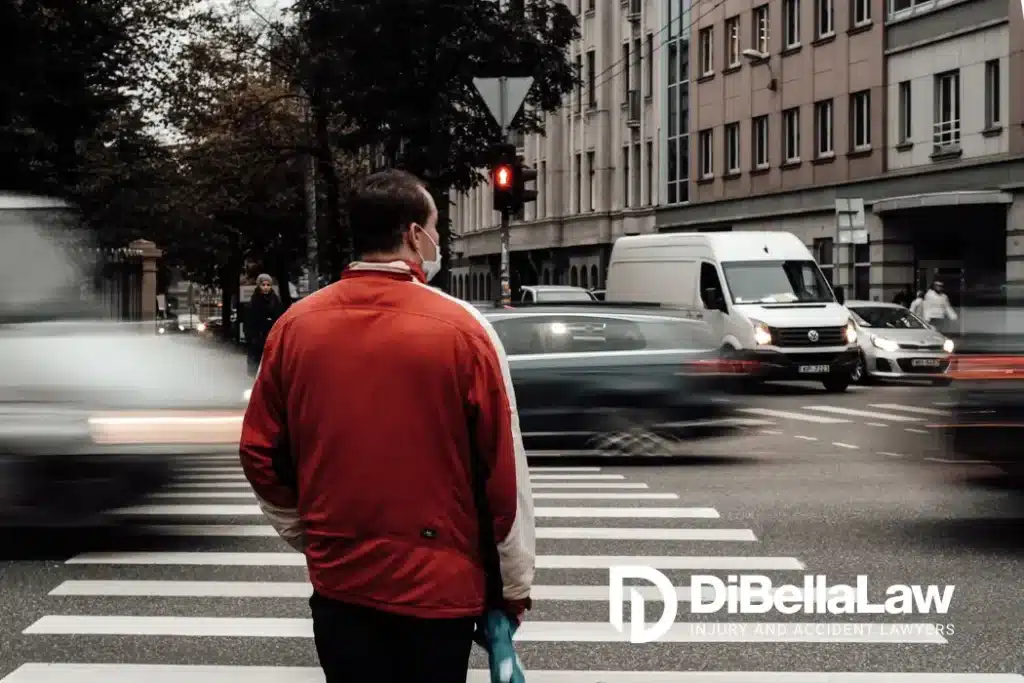On This Page
- Understanding Pedestrian Right-of-Way Laws in Massachusetts
- Pedestrian Responsibilities and Limitations
- Driver Responsibilities and Common Violations in Massachusetts
- What Happens in Pedestrian-Vehicle Accidents?
- Who’s at Fault? Shared Responsibility and Comparative Negligence
- Get Legal Help To Protect Your Pedestrian Rights
Generally, pedestrians do have the right of way in Massachusetts when walking in marked crossings and intersections, but not when jaywalking or crossing against the light. Pedestrian laws help keep our community safe and determine responsibility in lawsuits.
It’s important for all residents, visitors and people of the communities around Massahchusetts to understand responsibilities of both drivers and pedestrians, as well as the legal procedures for pedestrian accident lawsuits.
Understanding Pedestrian Right-of-Way Laws in Massachusetts
Massachusetts pedestrians have the right of way in the following scenarios:
- At a marked or unmarked crosswalk without a signal
- At a marked or unmarked crosswalk with a signal, when that signal indicates it’s okay to cross
- When crossing in front of a car trying to turn on red
- When crossing an alley or driveway
Pedestrians do not have the right of way when crossing against the light or crossing the street between two crosswalks.
While Massachusetts lacks specific pedestrian laws about school zones and other special areas, drivers should always exercise caution.
Pedestrian Responsibilities and Limitations
Pedestrian crossing laws in Massachusetts say you must yield to vehicles that have the green light and refrain from jaywalking. Generally, you should stick to marked sidewalks, obey all traffic signals, and exercise care and caution, especially when walking alongside a busy road or crossing an intersection.
Jaywalking may not seem serious. However, it’s illegal and can greatly impact your ability to collect damages in a lawsuit. For instance, let’s say you drop your wallet when crossing an intersection. You run back into the street to retrieve it, but the light has already changed, and a car hits you.
You can try to sue the driver, but they can argue that you are responsible because you were the one violating traffic laws. If you were even partially responsible for your accident, it can affect the compensation you can recover.
Driver Responsibilities and Common Violations in Massachusetts
Drivers must recognize the pedestrian’s right of way at crosswalks, not overtake other cars stopped at crosswalks, and obey all posted speed limits, especially in school zones and pedestrian-heavy areas.
Driver negligence is frequently a factor in pedestrian crashes. Failure to yield and speeding are among the most common driver violations in Massachusetts. These and other driver infractions often result from distracted driving. Drivers are prohibited from reading texts or using a phone that’s not in hands-free mode.
Failure to drive without distractions and follow traffic laws can cause serious consequences. We have obtained impressive results for pedestrians injured in such accidents, such as the following:

“We recovered $29,000 for our client who was walking, pushing two bicycles that were attached together by a bike lock. At the time, a vehicle was exiting a nearby parking lot. Despite having a red light at the intersection, the driver made a right-hand turn, striking our client with her vehicle. The client sustained injuries to his left leg and foot. The severity of the injuries required immediate medical attention and transportation to the hospital with several follow-up visits.”
What Happens in Pedestrian-Vehicle Accidents?
Every operator of a vehicle registered in Massachusetts must carry personal injury protection coverage, or PIP. This type of insurance pays medical bills and 75 percent of lost wages and replacement services, up to $8,000. If a car hits a pedestrian, that driver’s PIP will cover the pedestrian’s injuries, even if the driver wasn’t at fault.
PIP coverage is often sufficient for minor injuries resulting from small collisions. If you have sustained serious injuries such as broken bones, brain damage, or disfigurement in a pedestrian accident, PIP insurance will likely not cover your medical bills. In such a case, you might be eligible to pursue a personal injury claim against the at-fault party.
An experienced Massachusetts personal injury attorney can help you understand your legal options and how much money you can collect.
Who’s at Fault? Shared Responsibility and Comparative Negligence
Massachusetts has a modified comparative negligence system, meaning an accident victim may only recover compensation if they are less than 51 percent at fault for the accident. However, the compensation they can recover is reduced by their share of the fault.
For example, if a pedestrian jaywalks and a driver hits them, they may be found primarily at fault for the accident and unable to recover compensation.
However, if the driver was speeding, they might be found 60 percent at fault and the jaywalking pedestrian 40 percent to blame. Thus, the pedestrian can recover damages, but the compensation they can recover will be reduced by 40 percent.
A Boston pedestrian attorney can determine the cause of your accident and fight back against allegations os shared blame.
Get Legal Help To Protect Your Pedestrian Rights
Pedestrian accidents can cause serious injury and make you feel less safe within your community. At DiBella Law, a pedestrian attorney will provide a free case consultation to help you better understand your legal options. We can investigate, gather evidence such as dashcam footage, negotiate with insurance companies, handle all the legal paperwork, and fight for you in court if necessary.
Do pedestrians have the right of way in Massachusetts? Often, the answer is yes, and DiBella Law has helped hundreds of pedestrians from Massachusetts and surrounding areas determine how local laws apply in their situations.
There’s no fee unless you win, so call (617) 870-0907 or contact us online today.
